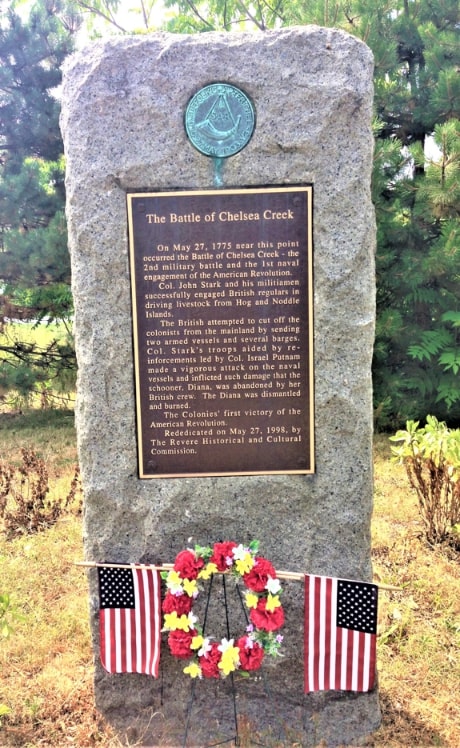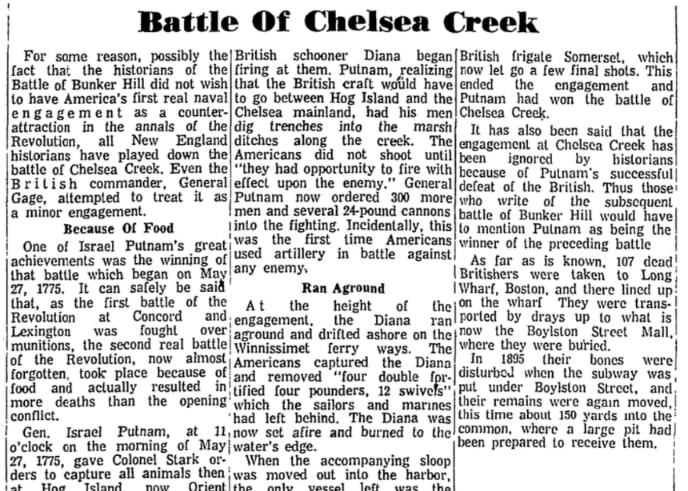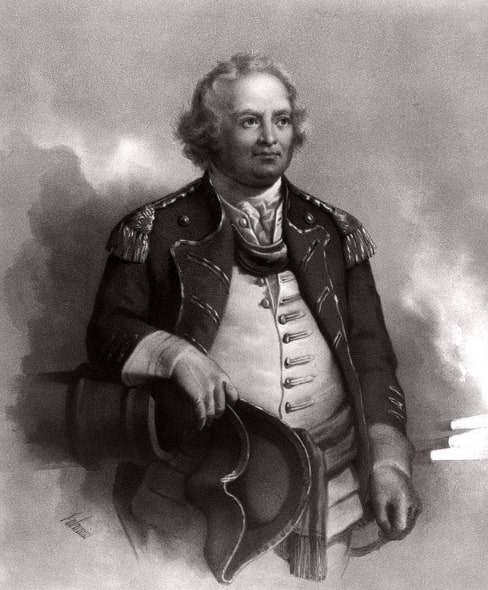Introduction: In this article for Memorial Day, Melissa Davenport Berry writes about the Battle of Chelsea Creek – the second battle of the Revolutionary War, and the Americans’ first victory. Melissa is a genealogist who has a blog, AnceStory Archives, and a Facebook group, New England Family Genealogy and History.
This story remembers all brave patriots who fought in the American Revolution, and even those red coat lads from the other side of the pond.
In 1970 Massachusetts Gov. Francis W. Sergeant, along with Sen. Mario Umana and Commander Joseph Keohane of the Boston Veterans Council, declared an official reenactment of a battle fought in the United States War of Independence to accompany the Memorial Day weekend celebrations.
This battle is long forgotten by many, but it happened to fall on the same dates we now celebrate as Memorial Day weekend. It was the second battle – and first naval engagement – of the Revolutionary War, and the Americans’ first victory.

It was the Battle of Chelsea Creek (sometimes called the Battle of Noddle’s Island, the Battle of Hog Island, or the Battle of the Chelsea Estuary). The reason for the various names is because it was fought on the islands, mudflats, and salt marshes in Boston Harbor.
The battle – a series of skirmishes – broke out on 27 May 1775, just 38 days after the combat between the minutemen and redcoats at Concord and Lexington began the Revolutionary War. The Battle of Chelsea Creek, northeast of Boston, extended into the next day.
Leave it to Edward Rowe Snow, the historian, Patriot Ledger columnist, and Flying Santa to tell the tale.
Snow’s column features a photo of Gregg Benjamin of the Bostonian Society (on the left) and George Gloss, a Boston bookman (to the right) pointing at the inscription on the gravestone of the British sailor and marines killed in the Battle of Chelsea Creek.

To begin, Snow asserts this battle was more about food than anything. And to source the real substance, here is a resolution from the meeting minutes of the Massachusetts Committee of Safety, 14 May 1775:
“Resolved, as their opinion, that all the livestock be taken from Noddle’s Island, Hog Island, Snake Island, and from that part of Chelsea near the sea coast, and be driven back; and that the execution of this business be committed to the committees of correspondence and selectmen of the towns of Medford, Malden, Chelsea, and Lynn, and that they be supplied with such a number of men, as they shall need, from the regiment now at Medford.”
Here is some of Snow’s account, from his column in the Patriot Ledger:
Gen. Israel Putnam [and Gen. Artemis Ward], at 11 o’clock on the morning of May 27, 1775, gave Colonel [John] Stark orders to capture all animals then at Hog Island, now Orient Heights. Reaching Hog Island, Colonel Stark and his men were noticed by British marines at Noddle’s Island, and a short skirmish followed. Six hundred New Hampshire and Massachusetts troops were now ready to engage the British at both Hog Island and Noddle’s Island.
The men transported 400 sheep away from the islands, but were interrupted when the armed British schooner Diana began firing at them. Putnam, realizing that the British craft would have to go between Hog Island and the Chelsea mainland, had his men dig trenches into the marsh ditches along the creek. The Americans did not shoot until “they had opportunity to fire with effect upon the enemy.” General Putnam now ordered 300 more men and several 24-pound cannons into the fighting. Incidentally, this was the first time Americans used artillery in battle against any enemy.
At the height of the engagement, the Diana ran aground and drifted ashore on the Winnisimmet Ferry ways. The Americans captured the Diana and removed “four double fortified four pounders, 12 swivels” which the [British] sailors and marines had left behind. The Diana was now set afire and burned to the water’s edge.
When the accompanying sloop was moved out into the harbor, the only vessel left was the British frigate Somerset, which now let go a few final shots. This ended the engagement and Putnam had won the battle of Chelsea Creek.

The diary of Samuel Bixby was sourced by the historian Mellen Chamberlain in 1908. Bixby, who was stationed in the Roxbury camp, captures some of the action during the Battle of Chelsea Creek:
Sat. May 27 – Early in morning, report of a cannon.
Sun. May 28 – At noon receive information that yesterday, Col. Putnam with a party went to Hog Island. He was opposed by the navy and army but came off victorious. It is supposed that a new move is made toward Chelsea.
Here is a report of the battle published in the Virginia Advertiser in 1775.

This article reported:
On Saturday last, a party of the American army at Cambridge, to the number of between 2 and 300 men, had orders to drive off the livestock from Hog and Noddle’s islands, which lie near Chelsea and Winnisimmet, on the N.E. side of Boston harbour. From Chelsea to Hog Island, at low water, it is but about knee high, and from that to Noddle’s Island about the same. The stock on the former belonged to Mr. Oliver Wendell, at Boston, and Mr. Jonathan Jackson, at Newburyport; that on Noddle’s Island was owned by Mr. Williams, of Boston, who hires the island.
About 11 o’clock A.M., between 20 and 30 men went from Chelsea to Hog Island, and from thence to Noddle’s Island, to drive off the stock which was there, but were interrupted by a schooner and a sloop, dispatched from the fleet in Boston harbour, and 40 marines, who had been stationed on the island to protect the livestock.
Read the rest of the story with sources at Americana-Archives.
To conclude: the battle fought those two days was considered one of Gen. Putnam’s greatest achievements, but is often overlooked today.
Snow noted that about 107 British men who died in the battle were taken to Long Wharf, laid out, then transported by drays up on what is now Boylston Street.
In 1895, when the subway was put in, their bones were unearthed and the remains were moved about 150 yards into the common. I was not able to locate a recent photo.
Have a good Memorial Day weekend!
Explore over 330 years of newspapers and historical records in GenealogyBank. Discover your family story! Start a 7-Day Free Trial
Note on the header image: “A plan of the town and harbour of Boston and the country adjacent with the road from Boston to Concord, shewing the place of the late engagement [Battle of Chelsea Creek] between the King’s troops & the provincials, together with the several encampments of both armies in & about Boston. Taken from an actual survey. Humbly inscribed to Richd. Whitworth by J. De Costa; C. Hall, sc.” Created: July 29, 1775, London. Credit: Library of Congress, Geography and Map Division.

